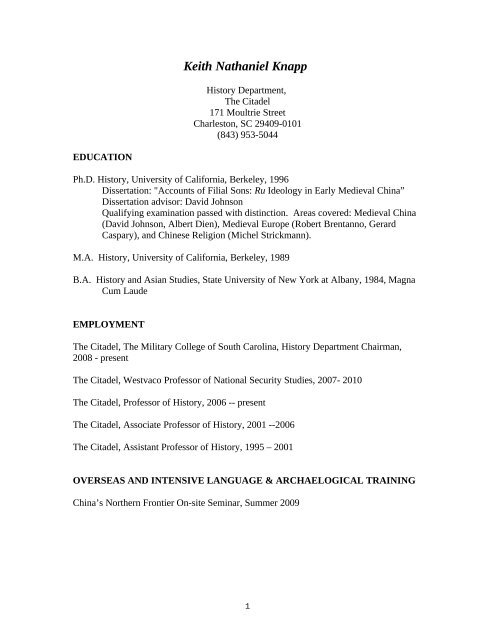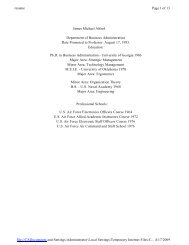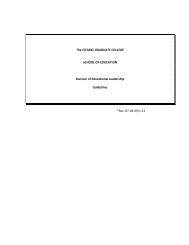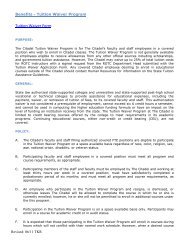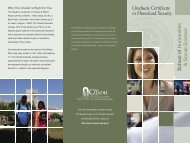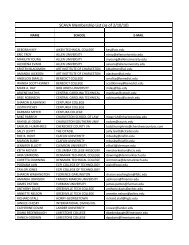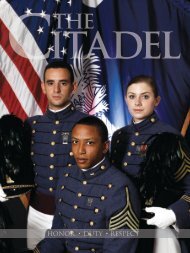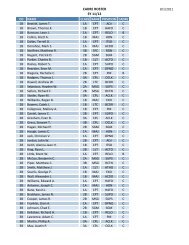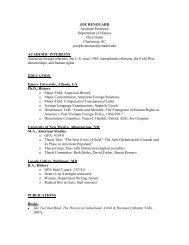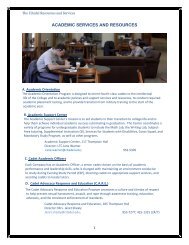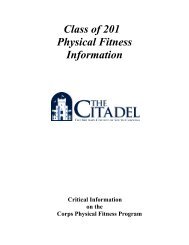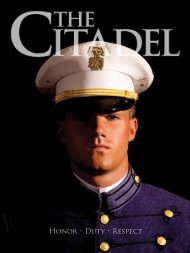Keith Nathaniel Knapp - The Citadel
Keith Nathaniel Knapp - The Citadel
Keith Nathaniel Knapp - The Citadel
- No tags were found...
Create successful ePaper yourself
Turn your PDF publications into a flip-book with our unique Google optimized e-Paper software.
“Heaven and Death according to Huangfu Mi, a Third-century Confucian,” EarlyMedieval China 6 (2000): 1-31."New Approaches to Teaching Early Confucianism," Teaching <strong>The</strong>ology and Religion2.1 (February 1999): 45-54."<strong>The</strong> Ru Reinterpretation of Xiao," Early China 20 (1995): 195-222.“Clay Roosters Cannot Lord over Mornings.” Transactions of the InternationalConference of Orientalists in Japan 37 (1992): 180-182.TRANSLATIONSKuroda Akira. “Are the Wu Liang Shrine Pictorial Stones Forgeries? Examining theHan Era Evidence,” Asia Major, Third Series 23.2 (2010): 129-151.Chen Shuguo, “State Religious Ceremonies.” Early Chinese Religion, Part Two: <strong>The</strong>Period of Division (220-589 AD), edited by John Lagerwey and Lü Pengzhi. Leiden:Brill, 2010, volume 1: 53-142.SCHOLARLY CONTRIBUTIONSSix Dynasties Handbook. Forthcoming.“Xiaozi zhuan”“Diaoyu ji can”Early Medieval China: A Sourcebook“Confucian Views of the Supernatural.” Forthcoming.Classical Traditions (1000 B.C.E. - 300 C.E.) volume of the ABC-CLIO Encyclopedia ofWorld History. Santa Barbara, CA: ABC CLIO, forthcoming.“<strong>The</strong> Chinese Family from the Zhou to the Han periods”“Didactic Images in the Public and Private worlds”“Education in Early China”“Food and Its Uses in Chinese Religion and Social Life”“Peasants in Sui and Tang China”“Qin and Han External Relations”“<strong>The</strong> Role of Merchants and Trade in Qin and Han China”Milestone Documents in World History: Exploring the Primary Sources That Shaped theWorld. Volume I: 2350 BCE- 1058 CE, edited by Brian Bonhomme. Dallas, TX:Schlager Group, 2010.“<strong>The</strong> Canon of Filial Piety,” 209-222.“Discourses on Salt and Iron,” 243-253.4
Berkshire Encyclopedia of China. Great Barrington, MA: Berkshire Publishing Group,2009.“Filial Piety,” 813-815.“Three Cardinal Guides and the Five Constant Virtues,” 2252-2255.ABC-CLIO Encyclopedia of Love in World Religions, edited by Yudit KornbergGreenberg. 2v. Santa Barbara, CA: ABC CLIO, 2008.“Confucianism,” 133-135“Filial Love,” 218-219Kuroda Akira 黒 田 彰 , Kôshidenzu no kenkyû 孝 子 伝 図 の 研 究 (Studies on theAccounts and Illustrations of Filial Children). Tokyo: Kyûko shoin, 2007.“Afterword,” 826-828.Encyclopedia of Religion: Second Edition, edited by Lindsay Jones. New York:MacMillan Reference, 2005."Xiao," 14: 9857-9858.Hawai'i Reader in Traditional Chinese Culture, edited by Victor H. Mair, Nancy S.Steinhardt, and Paul Rakita Goldin. Honolulu: University of Hawai’i Press, 2005.“Early Medieval Filial Piety Stories,” 278-281.<strong>The</strong> Internet Encyclopedia of Philosophy,http://www.utm.edu/research/iep/g/gehong.htm, 2003. James Fieser, General Editor;Jeffrey L. Richey, Area Editor for Eastern Philosophy."Ge Hong"Routledgecurzon Encyclopedia of Confucianism, edited by Yao Xinzhong. London:RoutledgeCurzon Press, 2003."Ai" 愛 (to cherish), 13"Ci" 慈 (kindness), 81"Confucianism and Women," 161-162"Ershisixiao" 二 十 四 孝 (<strong>The</strong> Twenty-four Filial Exemplars), 200-201"Fufu" 夫 婦 (husband and wife), 217"Fuzi" 父 子 (father and son), 218-219"Qin" 親 (love, intimacy), 490-491"Qinqin" 親 親 (loving one's beloved), 491-492"Renlun" 人 倫 (<strong>The</strong> Human Relations), 501-503"Sancong side" 三 從 四 德 (Thrice-fold Obedience and the Four Virtues), 524-525"Se" 色 (countenance, sensual beauty), 533-534"Ti" 悌 (brotherliness)," 604"Xiaozi zhuan" 孝 子 傳 (Accounts of Filial Offspring), 683-684"Zhangyou" 長 幼 (senior-junior), 802-803"Zhen" 貞 (steadfastness, chastity), 8105
"Zi" 子 (son or daughter), 851"Zizi" 子 子 (sonly sons), 852WORK IN PROGRESS“Early Medieval China Handbook,” manuscript. Editors Alan Berkowitz, CynthiaChennault, Albert Dien, and <strong>Keith</strong> N. <strong>Knapp</strong>“Accounts of Filial Children: A Translation of Two Medieval Chinese ManuscriptsPreserved in Kyoto,” manuscript“Purity and Privilege: <strong>The</strong> Social Values of Early Medieval China,” manuscriptBOOK REVIEWSStatecraft and Classical Learning: <strong>The</strong> Rituals of Zhou in East Asian History, edited byBenjamin A. Elman & Martin Kern. Journal of Asian Studies, forthcoming.China between Empires: <strong>The</strong> Northern and Southern Dynasties, by Mark Edward Lewis.American Historical Review 115.4 (October 2010): 1117-1118.<strong>The</strong> Confucian Quest for Order: <strong>The</strong> Origin and Formation of the Political Thought ofXun Zi by Sato Masayuki. Dao: A Journal of Comparative Philosophy 9.1 (2010): 125-128.“Early Confucianism Reconsidered” (Review article). Religious Studies Review 34.3(2008): 161-164.Death in Ancient China: <strong>The</strong> Tale of One Man’s Journey, by Constance A. Cook.Journal of Chinese Religions 36 (2008): 139-141.Community Schools and the State in Ming China, by Sarah Schneewind. InternationalJournal of Asian Studies, 4.2 (2007): 286-288.Representations of Childhood and Youth in Early China, by Anne Behnke Kinney.American Historical Review, 111.5 (2006): 1481-1482.A Tender Voyage: Children and Childhood in Late Imperial China, by Ping-chen Hsiung.Journal of Asian Studies 65.1 (2006): 165-166.Shaping the Ideal Child: Children and <strong>The</strong>ir Primers in Late Imperial China, by LiminBai. Journal of Chinese Studies 45 (2005): 395-401.Spirit and Self in Medieval China: <strong>The</strong> Shih-shuo hsin-yü and Its Legacy, by NanxiuQian. China Review International 10.1 (2003): 242-247.6
BOOKNOTESA Translation of the Ancient Chinese Book of Burial (Zang shu) by Guo Pu (276-324), byJuwen Zhang. Religious Studies Review 36.4 (2010): 314.<strong>The</strong> Art of Doing Good: Charity in Late Ming China, by Joanna Handlin Smith.Religious Studies Review, 36.3 (2010): 246.Emperor and Ancestor: State and Lineage in South China, by David Faure. ReligiousStudies Review 36.1 (2010): 99.Ritual Opera & Mercantile Lineage: <strong>The</strong> Confucian Transformation of Popular Culturein Late Imperial Huizhou, by Qitao Guo. Religious Studies Review, 35.3 (2009): 206.Imperial Tombs of Tang China, 618-907: <strong>The</strong> Politics of Paradise, by Tonia Eckfeld.Religious Studies Review, 35.1 (2009): 74.Mirror of Morality: Chinese Narrative Illustration and Confucian Ideology, by JuliaMurray. Religious Studies Review, 35.1 (2009): 75.A Tale of Two Melons: Emperor and Subject in Ming China, by Sarah Schneewind.Religious Studies Review 34.2 (2008): 128.Of Tripod and Palate: Food, Politics, and Religion in Traditional China, edited by RoelSterckx. Religious Studies Review, 33.2 (2007): 173-174.State and Religion in China, by Anthony C. Yu. Religious Studies Review, 33.2 (2007):173.Women and Confucian Cultures in Premodern China, Korea, and Japan, edited byDorothy Ko, Jahyun Kim Haboush, and Joan R. Piggott. Religious Studies Review, 32.4(October 2006): 271-272.Power of the Words: Chen Prophecy in Chinese Politics AD 265-618, by Zongli Lu.Religious Studies Review, 32.2 (2006): 138-139.Hsieh Liang-tso and the Analects of Confucius: Humane Learning as a Religious Quest,by Thomas W. Selover. Religious Studies Review, 32.2 (2006): 139.Rulin Waishi and Cultural Transformation in Late Imperial China, by Shang Wei.Religious Studies Review 30.4 (2004): 342-343.Monastic Life in Medieval Daoism: A Cross-Cultural Perspective, by Livia Kohn.Religious Studies Review 30 (2004): 283.7
On Sacred Grounds: Culture, Society, Politics, and the Formation of the Cult ofConfucius, edited by Thomas Wilson. Religious Studies Review 30 (2004): 237.Ordinary Images, by Stanley K. Abe. Religious Studies Review 29 (2003): 389.Auspicious Omens and Miracles in Ancient China, by Tiziana Lippiello. ReligiousStudies Review 29 (2003): 114.INVITED CONFERENCE PRESENTATIONS“Chinese Filial Cannibalism: A Silk Road Import?” Presented at the “Cultural Crossings:China and Beyond in the Medieval Period” conference, University of Virginia,Charlottesville, VA, March 11, 2010.“Borrowing Legitimacy from the Dead: <strong>The</strong> Confucianization of Ancestral Worship inEarly Medieval China.” Presented at the “Rituals, Pantheons, and Techniques: A Historyof Chinese Religion before the Tang” conference, Paris, December 19, 2006.“アメリカとヨーロッ パにおける 孝 子 伝 研 究 の 現 状 ” (Recent American and EuropeanResearch on Chinese Accounts of Filial Children). Presented at the annual meeting of theSetsuwa bungaku.kai (Society of Japanese Tale Literature), Bukkyô University, Kyoto,June 17, 2006."Filial Feeding: <strong>The</strong> Parent-child Relationship in Early Medieval Tales of FilialOffspring." Presented at the Conference on Conceptions of Filial Piety in ChineseThought and History, National University of Singapore, January 11, 2002.“Huangfu Mi de zongjiaoguan” 皇 甫 謐 的 宗 教 觀 (<strong>The</strong> Religious Views of HuangfuMi). Presented at the “Chinese Authors and Religion” conference, the third segment ofthe “Chinese Literature and Religion International Symposium,” Hong Kong, November5, 1998.“<strong>The</strong> Religious Vision of the Third-century Scholar and Recluse Huangfu Mi.”Presented at the “Society, Culture, and Religion in Medieval and Early Modern China: InCelebration of David Johnson’s Sixtieth Birthday” conference, Berkeley, California,August 22, 1998."You Are What You Eat: Food and Parental Authority in Medieval Tales of FilialDevotion." Presented at the "Uncovering the Past: Archaeology and History in MedievalChina and Central Asia: A conference on the occasion of the retirement of ProfessorAlbert E. Dien," Stanford, California, May 14, 1993.INTERNATIONAL & NATIONAL CONFERENCE PRESENTATIONS8
“Why did Early Medieval Historian frequently label Biographies of Filial Children“Accounts of the Filial and Righteous?” Presented at the International Symposium onAncient Chinese Biographical Literature, Beijing, China, December 18, 2010.“Daughter-in-law, <strong>The</strong>re is a Maggot in My Soup! Medieval Accounts of UnfilialChildren.” Presented at the Annual Meeting of the American Academy of Religion,Atlanta, GA, October 30, 2010.“Magistrates and Miracles: <strong>The</strong> Supernatural Arsenal of Fine Officials in Early MedievalChina.” Presented at the annual meeting of the American Historical Association, SanDiego, California, January 7, 2010.“Finding a New Audience: <strong>The</strong> Tang Popularization of Filial Piety Narratives.”Presented at the Annual Meeting of the American Academy of Religion, Montreal,Canada, November 7, 2009.“Magistrates and Miracles: <strong>The</strong> Supernatural Arsenal of Fine Officials in Early MedievalChina.” Presented at the Annual Meeting of the Association for Asian Studies, Chicago,IL, March 27, 2009.“Medieval Chinese Biographies of the Filial and the Righteous: <strong>The</strong> Guos as ConfucianCommoners.” Presented at the Collective Biography Conference, Research School ofHumanities Australia National University College of Arts and Social Sciences, Canberra,September 10, 2008.“Using Artifacts to Date Texts: <strong>The</strong> Case of the Accounts of Filial Children Manuscriptsin Kyoto.” Presented at the 4 th Worldwide Conference of the Society for East AsianArchaeology, Beijing, China, June 5, 2008.“Voluntary Obligations: <strong>The</strong> Client Relations of Guli 故 吏 and Mensheng 門 生 in EarlyMedieval China.” Presented at the Annual Meeting of the Association for Asian Studies,Atlanta, Georgia, April 4, 2008.“Personal Loyalties: <strong>The</strong> Virtue of Zhong 忠 in Early Medieval China.” Presented at theFifth International Convention of Asian Scholars. Kuala Lumpur, Malaysia, August 4,2007.“Where have all the Loyal Retainers Gone? <strong>The</strong> Conflict between Family and State inEarly Medieval China.” Presented at the Annual Meeting of the American Academy ofReligion. Washington, D.C., November 20, 2006.“<strong>The</strong> Remembered Dead: Ancestral Rites in Early Medieval China.” Presented at AnnualMeeting of the Association for Asian Studies, San Francisco, California, April 7, 2006."Learning Confucianism through Its Exemplars." Presented at the Annual Meeting of theAmerican Academy of Religion. Philadelphia, Pennsylvania, November 20, 2005.9
"<strong>The</strong> Subtle Art of Avoiding Profit: <strong>The</strong> Mercantile Adventures of a Fifth-CenturyConfucian Exemplar." Presented at the Annual Meeting of the American Academy ofReligion. Philadelphia, Pennsylvania, November 19, 2005."Why is Yang Gong a Filial Son? <strong>The</strong> Connection between Filiality and Righteousnessin Early Medieval China.” Presented at 47 th Annual Conference of the AmericanAssociation For Chinese Studies, Nashville, Tennessee, October 22, 2005."Filial Piety for Dummies: <strong>The</strong> Modification of the Funahashi Accounts of FilialOffspring for Popular Audiences." Presented at the Annual Meeting of the Associationfor Asian Studies, Chicago, Illinois, April 2, 2005."<strong>The</strong> Attraction of Filial Cannibalism: <strong>The</strong> Confucian Appropriation of the SujatiJâtaka." Presented at the Annual Meeting of the American Academy of Religion, SanAntonio, Texas, November 21, 2004."Local Virtue? Worthiness according to the fourth-century Huayang Guozhi." Presentedat the International Symposium on Chinese Local History, University of Utah, Salt LakeCity, November 6, 2004."Confucian and Christian Miracles in Early Medieval Eurasia." Presented at the 2003Annual Meeting of the American Academy of Religion, Atlanta, Georgia, November 25,2003."Ge Hong's Reconciliation of Taoism and Confucianism." Presented at the FirstInternational Conference on Ge Hong and Chinese Culture, Ningbo China, November 8,2003."Creeping Absolutism: Parental Authority as seen in Early Medieval Tales of FilialOffspring." Presented at the "Cultures of Authority in Asian Practice" on-lineconference, sponsored by the East-West Center in Honolulu, Hawaii, September 2-6,2003."<strong>The</strong> Naturalness of Filial Piety: A Study of Filial Animal Tales." Presented at the 38 thInternational Congress on Medieval Studies, Kalamazoo, Michigan, May 8, 2003."<strong>The</strong> Naturalness of Filial Piety: A Study of Filial Animal Tales." Presented at the 55 thAnnual Meeting of the Association for Asian Studies, New York, March 28, 2003."From Honoring Parents to Feeding <strong>The</strong>m in Style: <strong>The</strong> Transformation of Lowly Yanginto Exalted Gongyang in Early Medieval China." Presented at the Annual Meeting ofthe American Academy of Religion, Toronto, Canada, November 24, 2002."Family Roots and Imperial Opportunities: <strong>The</strong> Origins and Uses of Early MedievalFilial Piety Tales." Presented at the 37 th International Congress on Medieval Studies,10
Kalazamoo, Michigan, May 2, 2002.“Filial Suicide, Mutilation and Infanticide: Representations of Dutiful Daughters from theHan to the Yuan.” Presented at the 53 rd Annual Meeting of the Association for AsianStudies, Chicago, March 23, 2001.“Creeping Absolutism: Parental Authority as Seen in Filial Piety Tales.” Presented at the51 st Annual Meeting of the Association for Asian Studies, Boston, Massachusetts, March13, 1999.“Exceeding the Rites: Mourning Motifs in Chinese Tales of Filial Sons.” Presented at the50 th Annual Meeting of the Association of Asian Studies, Washington D.C., March 26,1998."Strategies for Teaching Confucianism." Presented at the Annual Meeting of theAmerican Academy of Religion, San Francisco, California, November 24, 1997."Chûgoku chûsei no hakusô ni tsuite" 中 國 中 世 の 薄 葬 について (Austere Burialsin Medieval China). Presented at the International Conference of Orientalists in Japan,Tokyo, May 24, 1992."Clay Roosters Cannot Lord over Mornings: the Meanings of Austere Burials inMedieval Death Testaments." Presented at the Annual Meeting of the Association forAsian Studies, New Orleans, Louisiana, April 1991.REGIONAL CONFERENCE PRESENTATIONS“Daughter-in-law, <strong>The</strong>re is a Maggot in My Soup! Medieval Accounts of UnfilialChildren.” Presented at the fourteenth annual meeting of the Southeast Early ChinaRoundtable, University of Kentucky, Lexington, Kentucky, November 13, 2010.“<strong>The</strong> Neglected Classic: <strong>The</strong> Importance of the Xiaojing 孝 經 .” Presented at theMidwest Conference in Chinese Thought, DePaul University, Chicago, Illinois, May 1,2010.“Filial Utopias: Early Medieval Conceptions of Local Governance.” Presented at thethirteenth annual meeting of the Southeast Early China Roundtable, University ofGeorgia, Athens, Georgia, October 24, 2009.“Filial Utopias: Early Medieval Conceptions of Local Governance.” Presented at theMidwest Conference in Chinese Thought 2009, Southern Illinois University, Carbondale,Illinois, April 18, 2009.“<strong>The</strong> Exemplary Everymen: Guo Shidao and Guo Yuanping as the Epitome of ConfucianCommoners.” Presented at the twelfth annual meeting of the Southeast Early China11
Roundtable, University of North Florida, Jacksonville, Florida, November 15, 2008.“Personal Loyalties: <strong>The</strong> Virtue of Zhong 忠 in Early Medieval China.” Presented at theEleventh Annual Meeting of the Southeast Early China Roundtable, Eckerd College, St.Petersburg, Florida, November 10, 2007.“Personal Loyalties: <strong>The</strong> Virtue of Zhong 忠 in Early Medieval China.” Presented at the33 rd Annual Meeting of the Southeast Medieval Association, Wofford College,Spartanburg, South Carolina, October 5, 2007.“Did the Middle Kingdom have a Middle Period? <strong>The</strong> Problem of “Medieval” in ChineseHistory.” Presented at the Tenth Annual Meeting of the Southeast Early ChinaRoundtable, <strong>The</strong> <strong>Citadel</strong>, Charleston, South Carolina, November 4, 2006.“Did the Middle Kingdom have a Middle Period? <strong>The</strong> Problem of “Medieval” in ChineseHistory.” Presented at the 32 nd Annual Meeting of the Southeast Medieval Association,University of Mississippi, Oxford, Mississippi, October 12, 2006."<strong>The</strong> Subtle Art of Avoiding Profit: <strong>The</strong> Mercantile Adventures of a Fifth-CenturyConfucian Exemplar." Presented at the Third Annual Mid-West Conference on EastAsian Thought, Southern Illinois University, Carbondale, Illinois, April 1, 2006."Learning Confucianism Through Filial Sons, Loyal Retainers, and Chaste Widows."Presented at the Ninth Annual Southeast Early China Roundtable, University of NorthCarolina, Chapel Hill, North Carolina, November 5, 2005."Differences between Kin: An Examination of Two Accounts of Filial OffspringPreserved in Japan." Presented at the Eighth Annual Southeast Early China Roundtable,University of Florida, Gainesville, Florida, October 16, 2004."Chinese Filial Cannibalism: A Silk Road Import?" Presented at the 29 th AnnualConference of the Southeastern Medieval Association, Fayetteville, Arkansas, October24, 2003."From Honoring Parents to Feeding <strong>The</strong>m in Style: <strong>The</strong> Transformation of Lowly Yanginto Exalted Gongyang in Early Medieval China." Presented at the Sixth AnnualSoutheast Early China Roundtable, Chattanooga, Tennessee, November 2, 2002."Filial Feeding: <strong>The</strong> Parent-child Relationship in Early Medieval Tales of FilialOffspring." Presented at the Columbia Traditional China and Korea Seminar, New YorkCity, New York, December 11, 2001.“Food, Hierarchy, and Self-deprivation: <strong>The</strong> Parent-child Relationship in Early MedievalTales of Filial Offspring.” Presented at the Fifth Annual Southeast Early ChinaRoundtable, Charlotte, North Carolina, November 3, 2001.12
Oxford University Press, Summer 2009GRANTS AND AWARDSSelected as President of the Early Medieval China Group, April 2010“100 Books for Understanding Contemporary Japan” grant from the Nippon Foundation,Spring 2009, on behalf of the <strong>Citadel</strong>’s Daniel LibrarySelected to be the History Department Chair from 2008 to 2012Selected as the first History Department recipient of the Westvaco Chair of NationalSecurity Studies, July 2007Inducted into the Phi Kappa Phi, a national honor society, April 25, 2004<strong>The</strong> Social Science Research Council Eurasia Program Teaching Fellowship, 2003-2005<strong>The</strong> <strong>Citadel</strong>'s Krause Faculty Award, 2002<strong>Citadel</strong> Foundation Full-Year Sabbatical Award, 2002-2003American Council of Learned Societies, National Program for Advanced Study andResearch in China Grant, administered by the Committee on Scholarly Communicationwith China and funded by the National Endowment of the Humanities, 1999-2000<strong>Citadel</strong> Foundation Research Grant, 1996-97, 1998-1999, 1999-2000, 2000-2001, 2001-2002, 2002-2003, 2003-2004, 2004-2005, 2005-2006, 2006-2007, 2007-2008<strong>Citadel</strong> Foundation Development Grant, Fall 1997, Summer 1998, Spring 1999, Summer1999, Summer 2004, Summer 2005, Fall 2007<strong>Citadel</strong> Foundation Presentation Grant, Spring 1996, Fall 1997, Fall 1998, Spring 1999,Fall 1999, Fall 2000, Spring 2001, Fall 2002, Spring 2002, Fall 2002 (2), Spring 2003(2), Fall 2003 (3), Fall 2004 (3), Spring 2005 (1), Fall 2005 (1), Spring 2006 (2), Fall2007(1),<strong>Citadel</strong> Development Foundation New Faculty Grant, 1996China Times Young Scholars Award 1993-94University of California Andrew Mellon Dissertation Write-up Grant 1992-93Foreign Language and Area Studies Travel Fellowship 1991-92University of Washington Twenty-five Dynastic Histories Database Travel Grant 1990Inter-University Center for Japanese Language Studies in Yokohama Grant, 1991-92Foreign Language and Area Studies Fellowship, 1988-91Inter-University Program for Chinese Language Studies in Taipei Fellowship 1985-87Princeton University Merit Fellowship 1984-85Presidential Research Award, State University of New York at Albany, 1984Phi Alpha <strong>The</strong>ta, International Honor Society in History, 1980New York State Regents Scholarship, 1979-83COURSES TAUGHTEast Asian Historical Conceptions of LeadershipHistory of Western Civilization (Part I)History of Western Civilization (Part II)History of World Civilization (Part I)14
2004 to 2010.Executive Council member of the Southeast Medieval Association, 2006-2009.Co-chair of the eighth annual Southeast Early China Roundtable, Gainesville, Florida,October 15-17, 2004.Steering committee member of the Chinese Religions Group, American Academy ofReligion, 2004 to 2006."Connecting Lowcountry Colleges to China." Paper presented at "East-West: <strong>The</strong>Carolina Connection, Seabrook Island, South Carolina, March 25, 2003.Member of the presidential nominating committee for the Early Medieval China Group,Fall 2002Board of Directors, Southeast Early China Roundtable, 1997-2005DEPARTMENTAL AND SCHOOL SERVICEInternational Education Study Group, 2008-2009Faculty Tenure and Promotion Committee Vice-Chair, 2006-2007Faculty Tenure and Promotion Committee Secretary, 2007-2008Assistant Professor of U.S. Foreign Relations Search Committee Chair, 2007-2008Adjunct Professor Search Committee Chair, summer 2006Research Committee Chair, 2004-2005Faculty Advisor to the Honor Committee, Fall 2003Research Committee, Fall 2000-2002, 2003-2006Sabbatical Committee, 1999-2000Faculty Development Committee, 1997-2001Intra-College Relations Committee, 1996-2001History Department Assessment Committee, 2001-2002History Department Curriculum Committee, 2004-2006History Department Curriculum Committee Chair, 2005-2006History Department Faculty Affairs Committee, 1997-2001, 2003-2004History Department Joint M.A. Program Committee, 2001-2002, 2003-presentHistory Department Student Affairs Committee, 1997-2001Faculty Advisor to the History Club, 1997-2001SERVICE TO THE COMMUNITYJudge at the first annual <strong>Citadel</strong> and College of Charleston Chinese Speech Contest,February 20, 2010.18
Volunteer at the Buist Academy for Advanced Studies library, Fall 07 - presentMember of the South Carolina Archives and History Commission. Fall 08- present.Lecturer in the Asian Studies Seminar. This seminar, which is offered by the SouthCarolina Center for Teaching about Asia (SCCTA) and funded by the FreemanFoundation, aims to enhance instruction on East Asia in local junior high andhigh school. Spring 2005, 2006, and 2007.Vice President and Secretary of the Chinese Association in Greater Charleston, 2002-2003 (First non-Chinese to be an officer in this organization).Instructor of Chinese culture and English composition, Charleston Chinese LanguageSchool, 2002-2003.INVITED COLLEGE AND MUSEUM LECTURES“Exemplary Everymen: Confucian Commoners in Early Medieval China.” Presented atQinghua University, Beijing, China, December 17, 2010.“Exemplary Everymen: Confucian Commoners in Early Medieval China.” Presented atthe University of Georgia, Athens, Georgia, April 26, 2010.“Exemplary Everymen: Confucian Commoners in Early Medieval China.” Presented atthe University of Arkansas, Fayetteville, Arkansas, April 8, 2010.“Exemplary Everymen: Confucian Commoners in Early Medieval China.” Presented atthe Center for East Asian Studies, University of Pennsylvania, Philadelphia,Pennsylvania, March 24, 2010.“Han Confucianism as seen through Moral Stories.” Presented at Belmont University,Nashville, Tennessee, on September 17, 2009.“<strong>The</strong> Contours of Life and Death in Early China as seen in Tomb Furnishings.”Presented at the Columbia Art Museum, Columbia, South Carolina, May 3, 2009“<strong>The</strong> First Emperor’s Family Values.” Presented at the Bowers Museum, in Santa Ana,CA, in conjunction with the exhibit Terra Cotta Warriors: Guardians of China’s FirstEmperor, on July 27, 2008.“East Asian Religions and their Impact on Contemporary East Asia” and “<strong>The</strong> History ofJapan and Mongolia.” Presented in the U.S. Air Force Special Operations School’s Asia-Pacific Orientation Course, at Hulburt Field, FL, on October 15, 2007, April 24, 2008,October 25, 2008, and May 18, 2009, at Kadena, Okinawa, Japan, on July 12, 2007,December 18, 2008, and August 12, 2009, at Camp Smith, Honolulu, Hawai’i, onJanuary 26, 2009, at Hulburt Field, FL, on September 2, 2010, and at Hulburt Field, FL,19
on November 18, 2010."Chinese Filial Piety: A Silk Road Import?" Presented to the ASIA group at theUniversity of North Carolina, Asheville, April 16, 2004."Filial Feeding: <strong>The</strong> Parent-Child Relationship in Early Medieval Chinese Tales of FilialOffspring." Presented at Southern Methodist University, Dallas, Texas, October 2, 2002.“Sanitizing Filial Piety: Changing Images of Filial Piety Tales.” Presented at the CroftInstitute of International Studies at the University of Mississippi, Oxford, Mississippi,August 27, 2001.INVITED PUBLIC LECTURES“Confucianism as seen through Moral Stories.” Presented at Somerby Rental RetirementCommunity. Mt. Pleasant, South Carolina, November 13, 2009.“Filial Utopias: Early Medieval Conceptions of Local Governance.” Presented at theChina’s Northern Frontier On-site Seminar, Guyuan, China, July 17, 2009.“Frustrated Nationalisms: <strong>The</strong> Friction between China and Tibet.” Presented at theKiwanis Club. Charleston, South Carolina, May 1, 2008."Confucian Values' Continued Relevance in Contemporary China." Presented at <strong>The</strong><strong>Citadel</strong> as part of “China at <strong>The</strong> <strong>Citadel</strong>” week. Charleston, South Carolina, October 30,2006.“Selfless Offspring: Filial Children in Early Medieval China.” Presented to the PhiAlpha <strong>The</strong>ta History honor society, <strong>The</strong> <strong>Citadel</strong>, Charleston, South Carolina, February14, 2006.“<strong>The</strong> Great Wall or Long Walls?: Fortifications and the Frontier in Pre-modern China.”Presented at Buist Academy, January 25, 2006."<strong>The</strong> Challenges and Blessings of International Marriages." Presented at James IslandCharter High School, Charleston, South Carolina, December 21, 2005."Down on the Farm: <strong>The</strong> Hard Life of the Tokugawa Farmer." Presented at the GibbesMuseum of Art, Charleston, South Carolina, December 2, 2005."Some Things Never Get Old: <strong>The</strong> Archaic yet Vibrant Chinese Writing System."Presented at Summerville High School, Summerville, South Carolina, October 27, 2005."<strong>The</strong> All-American Un-Americans: Asian Immigrants and their Struggle for Belonging inAmerica." Presented in honor of Asian Pacific Heritage Month at the United States20
Department of State Financial Services Center, Charleston, South Carolina, May 18,2005.“An Entombed World: Medieval China as seen in its Grave Goods and Tomb Murals.”Presented at the Low Country Senior Citizen Center, Charleston, South Carolina, April18, 2005.“An Entombed World: Medieval China as seen in its Grave Goods and Tomb Murals.”Presented at the <strong>The</strong> <strong>Citadel</strong>’s College of Graduate and Professional Studies’ SeniorScholar Program, Charleston, South Carolina, April 13, 2005."An Entombed World: Medieval China as seen in its Grave Goods and Tomb Murals."Presented at Phi Kappa Phi's "Brown Bag" Symposium, <strong>The</strong> <strong>Citadel</strong>, Charleston, SouthCarolina, March 30, 2005."China: <strong>The</strong> Once and Future King." Presented in honor of Asian Pacific HeritageMonth at the Ralph H. Johnson VA Medical Center in Charleston, South Carolina, May5, 2004."Islam in the Chinese Past." Presented at "<strong>The</strong> U.S. and the Muslim WorldsSymposium," College of Charleston, Charleston, South Carolina, March 30, 2004."Water Overcomes Rock: Taoism's Penetration of Western Thought." Presented at the"Culture, Conversation, and Convergence: <strong>The</strong> East-West Connection" conference, whichwas sponsored by the South Carolina International Education Consortium, inMcCormick, South Carolina, March 12, 2004."<strong>The</strong> Tôkaidô Road and Its Place in Tokugawa Popular Culture." Presented at the GibbesMuseum of Art, Charleston, South Carolina, January 26, 2004."Confucian Values' Continued Relevance in Contemporary China." Presented at the Mt.Pleasant Library under the sponsorship of the Chinese Association in Greater Charleston,June 28, 2003."<strong>The</strong> Year of the Ram." Presented at the Mt. Pleasant Library, Mt. Pleasant, SouthCarolina, February 15, 2003."<strong>The</strong> Manners and Mores of China." Presented at the Robert Ivey Ballet Studio, WestAshley, South Carolina, July 1, 2002."<strong>The</strong> Chinese New Year." Presented at a meeting of Girl Scout Troop 382 inSummerville, South Carolina, February 22, 2002."<strong>The</strong> Chinese Zodiac." Presented at the Mt. Pleasant Public Library, Mt. Pleasant, SouthCarolina, February 16, 2002.21
“<strong>The</strong> American and Chinese Love/Hate Relationship.” Presented at the YouthLeadership Conference, Mt. Pleasant, South Carolina, June 22, 2001.“Japan: Stability at What Price?” Presented at the Georgetown Senior Scholar Programin Georgetown, South Carolina, April 13, 1999.“<strong>The</strong> Postwar Economies and Societies of China and Japan.” Presented at the ForeignAffairs Forum in Charleston, South Carolina, February 23, 1999.“China: a Competitor Not an Enemy.” Presented at the Georgetown Senior ScholarProgram in Georgetown, South Carolina, March 24, 1998.“<strong>The</strong> Significance of Hong Kong’s Return to China.” Presented at the Shepherd Center,West Ashley, February 9, 1998.“China’s Recovery of Hong Kong.” Presented at the <strong>The</strong> <strong>Citadel</strong>’s College of Graduateand Professional Studies’ Senior Scholar Program, Charleston, South Carolina,September 10, 1997.MEMBERSHIPSAmerican Academy of ReligionsAssociation for Asian StudiesEarly Medieval China Group (President)Society for East Asian ArchaeologySociety for the Study of Early ChinaSoutheast Early China Roundtable (Board of Advisors, Chair 2005- present)Tang Studies SocietyWorld History AssociationLANGUAGESChinese (Mandarin and Classical)JapaneseFrench (reading only)22


